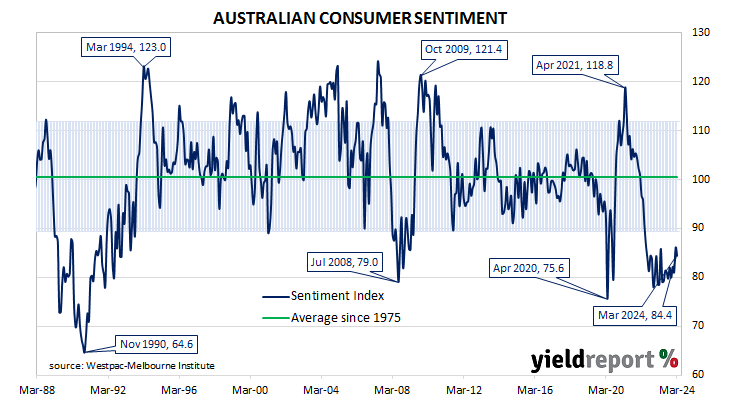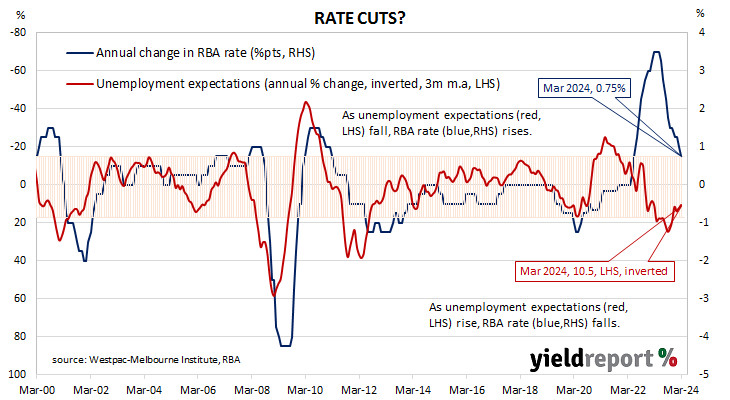Summary: Westpac-Melbourne Institute consumer sentiment index down in March; consumers still deeply pessimistic, becoming more concerned about near-term outlook; ACGB yields increase modestly; rate-cut expectations soften slightly; still some signs of improvement, responses suggest inflation ‘crisis’ less acute; four of five sub-indices lower; more respondents expecting higher jobless rate.
After a lengthy divergence between measures of consumer sentiment and business confidence in Australia which began in 2014, confidence readings of the two sectors converged again in mid-July 2018. Both measures then deteriorated gradually in trend terms, with consumer confidence leading the way. Household sentiment fell off a cliff in April 2020 but, after a few months of to-ing and fro-ing, it then staged a full recovery. However, consumer sentiment has languished at pessimistic levels since mid-2022 while business sentiment has been more robust.
According to the latest Westpac-Melbourne Institute survey conducted in the third week of March, household sentiment has deteriorated and remains at quite a pessimistic level. Their Consumer Sentiment Index slipped from February’s reading of 86.0 to 84.4, a reading which is still below the “normal” range and significantly lower than the long-term average reading of just over 101.
“The March survey update shows that progress continues to be slow at best,” said Westpac senior economist Matthew Hassan. “Consumers are still deeply pessimistic and becoming more concerned about the economy’s near-term outlook.”
Any reading of the Consumer Sentiment Index below 100 indicates the number of consumers who are pessimistic is greater than the number of consumers who are optimistic.
Commonwealth Government bond yields increased modestly on the day. By the close of business, the 3-year ACGB yield had inched up 1bp to 3.60%, the 10-year yield had added 2bps to 4.04% while the 20-year yield finished 3bps higher at 4.36%.
In the cash futures market, expectations regarding rate cuts later this year softened slightly. At the end of the day, contracts implied the cash rate would remain close to the current rate for the next few months and average 4.31% through April, 4.295% in May and 4.27% in June. However, August contracts implied a 4.15% average cash rate, November contracts implied 3.965%, while February contract implied 3.81%, 51bps less than the current rate.
“There are still some signs of improvement, particularly in consumer responses to questions on news recall,” added Hassan. ”Inflation continues to dominate the news cycle, but responses suggest the cost-of-living ‘crisis’ has become less acute. Recall levels have eased back to 43% from the 60%+ highs seen last year when the issue was effectively drowning out everything else.”
Four of the five sub-indices registered lower readings, with the “Economic conditions – next 12 months” sub-index posting the largest monthly percentage loss.
The Unemployment Expectations index, formerly a useful guide to RBA rate changes, increased from 126.9 to 128.1. Higher readings result from more respondents expecting a higher unemployment rate in the year ahead.



